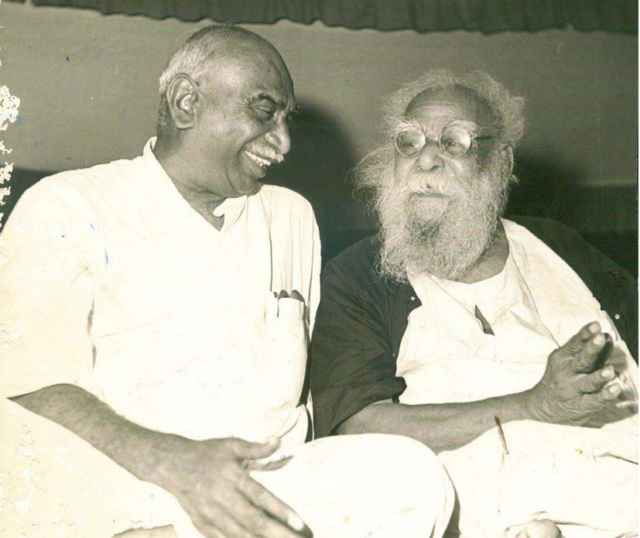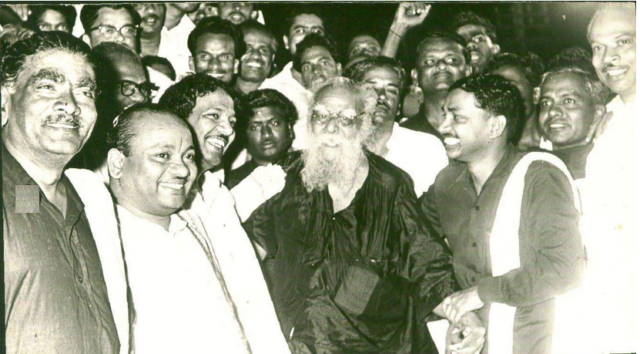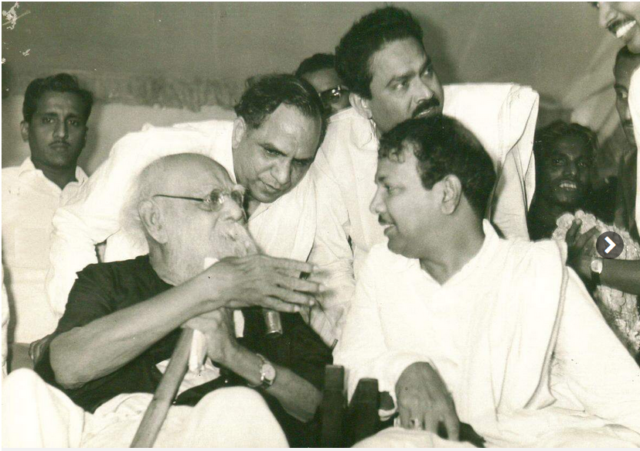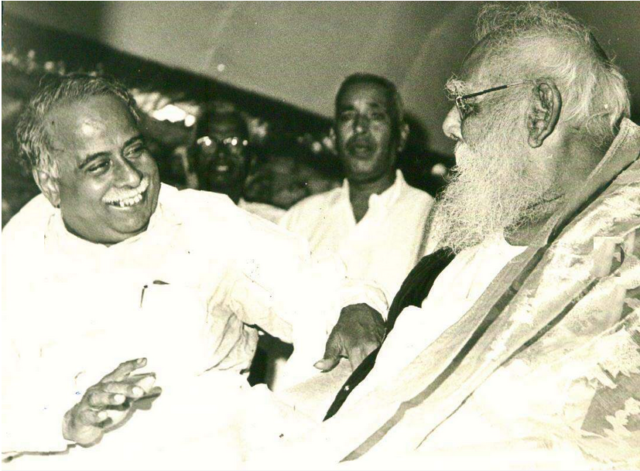PREVIOUS
Erode Venkatappa Ramasamy
September 22 , 2018
2045 days
138355
0
Erode Venkatappa Ramasamy
- Erode Venkata Ramasamy was born on 17 September 1879, Kannada speaking family in Erode.
- V. Ramasamy's father was Venkatappa Naicker (or Venkata), and his mother was Chinnathyee.
- V. Ramasamy married when he was 19. His first wife, Nagammai, died in 1933. He had a daughter who lived for only 5 months.
- V. Ramasamy married for a second time in April 9, 1949. His second wife, Maniammai, continued E.V. Ramasamy's social work after his death in 1973.
- Erode Venkatappa Ramasamy was an Indian social activist, and politician who started the Self-Respect Movementand Dravidar Kazhagam.
- He is known as the 'Father of modern Tamilnadu' as well as Paguththarivu Pagalavan.
- Periyar died on December 24,1973 at the age of 95.
- In 1978, India Post issued stamp on EVR
Early life
- In 1885 at the age of 6, periyar was sent to a small primary school.
- In 1889 at the age of 10, his school carreer ended within 5 years.
- In 1891 at the age of 12, he entered his father’s trade.
- He could speak three Dravidian languages: Kannada, Telugu and Tamil.
Periyar – Title
- The title "Periyar" was conferred on him by Tamil Nadu Women Conference held in Madras on 13-11-1938 under the presidentship of Neelambigai Ammaiyaar daughter of Maraimalai Adigal, a veteran Tamil Scholar. Dr. Dharmambal gave the title of “Periyar”to him.
- The word ‘periyar’ meaning 'respected one' or 'elder' in Tamil.

Kasi Pilgrimage incident
- In 1904, E.V. Ramasamy went on a pilgrimage to Kasito visit Shiva temple of Kashi Vishwanath.
- He witnessed immoral activities such as begging, and floating dead bodies.
- One particular incident in Kasi had a profound impact on E.V. Ramasamy's ideology and future work.
Member of Congress Party (1919–1925)
- V. Ramasamy joined the Indian National Congressin 1919.
- He held the chairmanship of Erode Municipality (1918) and wholeheartedly undertook constructive programs spreading the use of Khadi, picketing toddy shops, boycotting shops selling foreign cloth, and eradicating untouchability.
- As soon as the command of Gandhi for wearing Khadhi cloth was announced, Periyar immediately shed away all his costly foreign clothes and began to wear Khadhi. Also he forced all the members of his family, including his mother, aged 80 years to wear Khadhi dress only.
- He was arrested during the Non-Cooperation movement (1920).
- In 1921, Periyar courted imprisonment for picketing toddy shops in Erode.
- In 1921, during the anti-liquor campaign he cut down 1000 trees in his own farm.
- In 1922 Periyar, his wife Nagammal and sister Kannammal also bravely jumped into the agitation and they led women volunteers for picketing in front of liquor-shop.

- In 1922, Periyar was elected the President of the Madras PresidencyCongress Committee during the Tirupur session, where he advocated strongly for reservation in government jobs and education.
- His attempts were defeated in the Congress party due to a strong presence of discrimination and indifference, which led to his leaving the party in 1925.
- Periyar made the last and sixth attempt at getting the Tamil Nadu Congress to pass the resolution regarding communal representation at a conference held in Kanchipuram in 1925.
- Thiru V.Ka was the President at the time and sensing opposition in the open session, he did not permit Periyar to propose the resolution. In utter disgust, Periyar left the Congress.
- His repeated public meetings on the question of communal representation forced the government to pass G.O.No.1129 on 15 December 1928 by which Brahmins, non-Brahmins, Christians, Muslims and depressed classes were assured of proportionate representation in public offices.
Vaikom sathyagraha (1924-1925)
- The objective of the Satyagraha (30th March 1924) was to secure for untouchables the right to use a road near a Shiva/ Mahadeva temple at Vaikom, Kottayam district, Kerala.
- In Kerala, a committee was formed comprising people of different castes to fight untouchability.The committee was chaired by K Kelappan; the rest of the members were T K Madhavan, Velayudha Menon, Kurur Neelakantan Namboodiripad and T R Krishnaswami Iyer.
- Gandhiji, Chatampi Swamikal, and Sree Narayana Guru also participated in this movement.
- Before Periyar, vaikom sathyagraha was started by three leaders. They were
- K Madhavan
- P Kesava Menon
- George Joseph.
- Kerala people requested Periyar to come from Tamil Nadu to take up the leadership of Sathyagraha. He led the agitation. Hence, he was arrested and sent to jail. In that case, he was sentenced twice. Then the streets were thrown open to the Untouchables.
- That courageous movement got victory. The title of honour as "Hero of Vaikom" was conferred on Periyar.
Cheranmadevi Gurukulam - 1925
- In a place called Cheranmadeviin Tirunelveli district, a residential school, also known as Gurukulam, was started and managed by V.S. Iyer.
- In Cheranmadevi Gurukulam Periyar found that Brahmin children and Non-Brahmin children were given food in separate places.
- He advised Iyer to treat children alike. Periyar addressed public meetings about it and created public awareness of what was happening in Gurukulam.
- Periyar also raised this point in the state congress meeting. At last the school was closed.
Self-respect movement – 1925
- After quitting the congress, Periyar started Self – respect movement in 1925.
- The aims of the ‘Self -Respect Movement’ were to uplift the Dravidians and to expose the Brahminical tyranny.
- The first provincial conference of Self-Respect Movement was organised by Periyar at Chengalpattu in February 1929. Mr. W.P.A. Soundara Pandian, presided over that conference. In that conference soundrapandiyanar, kutthusi gurusamy, moovalur ramamirtham ammaiyar also participated.
- At Erode, the Second Provincial Conference of the Self Respect Movement was convened by Periyar under the chairmanship of Mr. M.R. Jayakar from Pune, a rationalist leader.
- Periyar introduced a new rationalist marriage system called "Self-Respect Marriage”.
Opposition to Hindi
- In 1938 April 21, Chakravarthi Rajagopalachari, the Chief Ministerof Madras Presidency, he introduced Hindi as a compulsory language of study in 125 secondary schools, thereby igniting a series of anti-Hindi agitations.
- Periyar and the opposition Justice Party led by T. Panneerselvamimmediately opposed the move.
- Moovalur Ramamirtham, Narayani, Va. Ba. Thamaraikani, Munnagar Azhagiyar, Dr. Dharmambal, Malar Mugathammaiyar, Pattammal and Seethammal were some of the women who were arrested for participating in the hindi agitation.

- In 1938 the slogan "Tamil Nadu for Tamilians" was first raised by E.V. Ramasamy in protest against the introduction of Hindi in schools.
- V. Ramasamy explained that Hindi would not only halt the progress of Tamil people, but would also completely destroy their culture and nullify the progressive ideas.
- Two persons -Thalamuthu and Natarajan - lost their lives.
- The agitation was also supported by Tamil scholars like Maraimalai Adigal, Somasundara Bharathi, K. Appadurai, Mudiyarasan, A. P. Viswanathamand Ilakkuvanar.
- Observing an anti-Hindi day on 1 July and 3 December 1938.
- On 21 February 1940, Madras Governor Erskine issued a press communique withdrawing compulsory Hindi teaching and making it optional.
Justice Party – President (1938–1944)
- A political party known as the South Indian Libertarian Federation (commonly referred to as Justice Party) was founded in 1916, principally to oppose the economic and political power of the Brahmin groups.
- The party's goal was to render social justiceto the non-Brahmin groups.
- V. Ramasamy took over the leadership of the party in 1938.
Dravidar kazhagam
- At a rally in salem under the leadership of Periyar at 1944 Aug 27, annadurai passed a resolution and declared that the justice party would henceforth be known as the Dravidar Kazhagam.
- It focused its attention on the liberation of women, women's education, willing marriage, widow marriage, orphanagesand mercy homes.

- In 1949 Conjeevaram Natarajan Annadurai, established a separate association called the Dravida Munnetra Kazhagam (DMK), or Dravidian Progressive Federation.
Journals and Books– Periyar
- In 1925 May 2, Periyar published a Tamil Weekly under the title “Kudi Arasu” edited by himself to spread the principles of Self-Respect.
- Periyar published an English magazine under the title "Revolt" on 7-11-1928.
- In 1930 Periyar published his book on "Family Planning" (Birth Control) and propagated restriction of number of children.
- In 1933 another magazine 'Puratchi' (Revolution) was published by Periyar.
- Periyar brought out the Tamil weekly 'Pagutharivu' (Rationalism) on 12-1-1934.
- Periyar wrote and published a book titled as “Pen Yenn adimaiyanaal?”.
- Justice Party started the Tamil weekly paper "Viduthalai" on 1-6-1935. Then it was entrusted to Periyar who published 'Viduthalai' as Tamil Daily Newspaper from 1-1-1937.
- On 22-01-1950 Periyar was sentenced to undergo imprisonment for the publication of his book 'Ponmozhigal' (Golden sayings).
- In 1970 The Tamil Bi-monthly, the "Unmai" (Truth) was first started at Tiruchirapalli by Periyar.
- Why I am an Atheist is an essay written by Indian revolutionary Bhagat Singh in 1930 in Lahore. On the request of Periyar E. V. Ramasamy, P. Jeevanandham translated the essay to the Tamil language.
- In 1935 January 13, Periyar introduced Reforms in Tamil Language, which was later implemented by the Tamilnadu Government under MG Ramachandran as Chief Minister in the year 1978.
Periyar last speech
- In 1973 December 19 At Thiyagaraya Nagar, Chennai - Periyar delivered his last speech (the Swansong).
UNESCO
- On 27th June 1970 by the UNESCO organization honored Periyar as “The Socrates of South Asia”.
- UNESCOdescribed Periyar as
- The prophet of the new age
- Father of social reform movement and
- Arch enemy of ignorance, superstitions, meaningless customs.
- - - - - - - - - - - - -
Leave a Reply
Your Comment is awaiting moderation.


